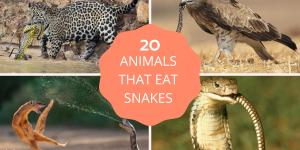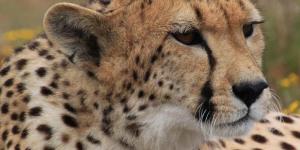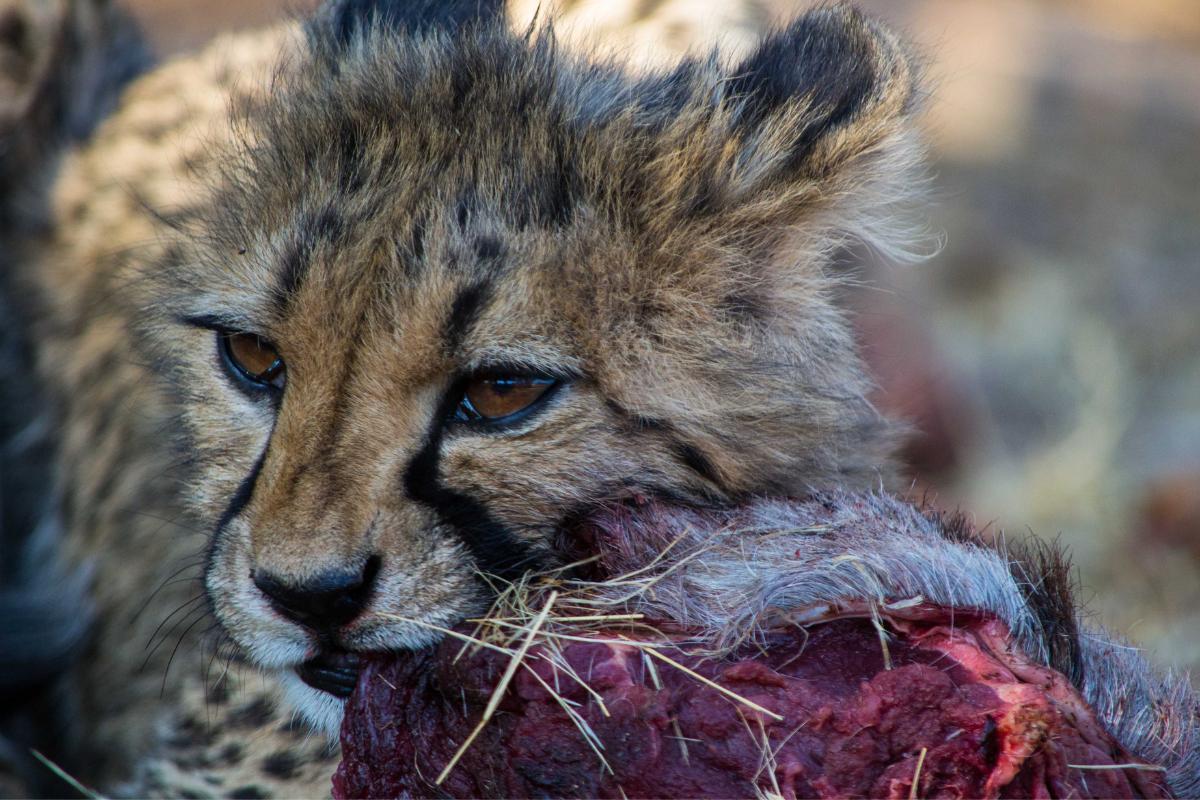Cheetah Diet - Animals That Cheetahs Eat

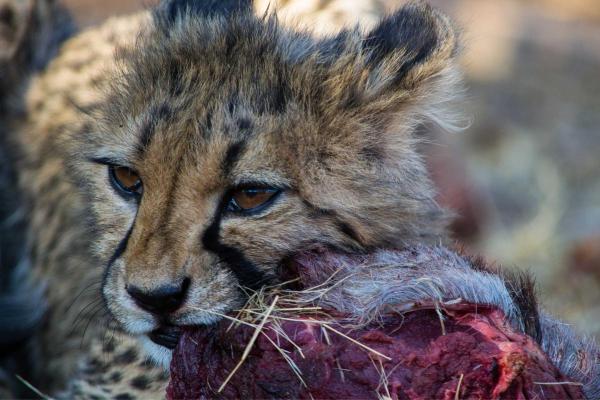
Known for their astonishing speed, the cheetah (Acinonyx jubatus) is an able hunter and an apex predator in their habitat. They have no natural predators of their own when adults, although they may face competition when it comes to hunting prey. While speed is their advantage, so too is stealth, hunting strategy, camouflage and agility. This great hunting skills means they are able to attack, kill and consume a wide range of prey. This includes animals which are otherwise too fast for other predators to capture. Such ability doesn't mean they are always successful in their kill, since their environment and potential prey can create various challenges to hinder them.
At AnimalWised, we learn all about the cheetah diet by looking at what animals cheetahs eat. We look at the difference between what adults cheetahs eat and the diet of cheetah cubs. We also explain in detail the hunting strategies cheetahs use to ensure they are able to compete in their often difficult habitats.
What is the cheetah diet?
Cheetahs maintain a highly specialized carnivorous diet based exclusively on meat from other animals. This means they are considered obligate carnivores, being unable to get the nutrients they need without consuming animals. While their diet is incredibly varied, they prioritize medium-sized prey such as gazelles, antelopes and smaller types of ungulate animals which have become fundamental elements of their diet.
The diet of cheetahs can vary depending on the availability of prey in their environment. Their instinct for survival has made them into opportunistic predators when choosing their prey. Although their preferences include gazelles, antelopes and young wildebeests, they may hunt birds or small mammals in some regions depending on availability and ecosystem conditions.
Once cheetahs have captured their prey, they display rapid consumption behavior. This habit is not only linked to the need to satisfy their appetite efficiently, but also minimizes the risk of losing prey to other predators or scavengers. With the reduction in prey animals, competition increases. This can make other predators more desperate, risking attacks by the cheetah to steal some of their prey.
The carnivorous diet of cheetahs is afforded by certain physiological adaptations, such as sharp teeth and non-retractable claws. Their teeth allow them both to kill prey and to tear the meat for consumption. Non-retractable claws provide them better traction on the ground, something which contributes to their supreme sprinting ability.
A specialization for hunting medium-sized prey combined with their incredible speed makes them adept predators in their environment. While this makes them apex predators in some ecosystems, this is not always the case. There are areas where the cheetah may live close to a lion population. In these cases, the lion may be dominant or at least provide competition for hunting prey. It is also possible lions will hunt cheetahs, although it is rare.
Compare the cheetah to other big cats with our article on the difference between cheetahs, leopards and jaguars.
What do cheetah cubs eat?
Newborn cheetahs are known as cubs. As with all mammals, cheetah mother feed their young with milk. The mother cheetah's milk is essential for the initial growth and development of the cubs. During the first weeks of life, cheetah cubs feed exclusively on their mother's milk. The milk contains the necessary nutrients to strengthen their immune system and provides the energy required for their rapid growth.
As cheetah cubs grow, they begin to gradually incorporate raw meat into their diet. This process occurs in parallel with their physical development and the acquisition of hunting skills. The mother introduces the cubs to hunting, sharing small prey and teaching them essential survival skills. This is a process known as weaning.
The transition of cheetah cubs from breast milk to a more carnivorous diet typically occurs around three months of age. At this point in their development, the cubs begin to chew and consume smaller prey. This transition process is crucial for young cheetahs to acquire the skills necessary for hunting and prepare for a full carnivorous diet in adulthood.
During the first months of life, the survival of the cubs largely depends on the protection and provision of the mother. The gradual transition to a carnivorous diet reflects the natural adaptation of young cheetahs to their environment and their evolution as specialized predators.
Learn more about the characteristics and challenges of their habitat with our article asking where do cheetahs live?
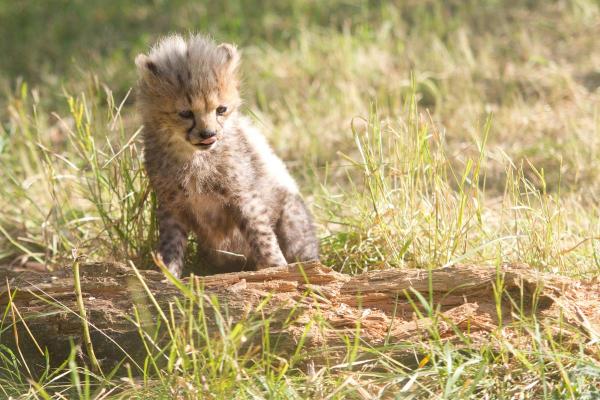
What animals do cheetahs eat?
As we have explained, cheetahs are types of carnivorous animal. Once the cheetah cubs are weaned off their mother's milk, they will consume animal meat almost exclusively with medium-sized prey animals being their preference.
The animals which cheetahs hunt are largely hoofed animals such as antelopes, gazelles and impalas. They are able to catch these speedy animals thanks to their own agility and velocity on the ground. However, they will also eat other animals depending on factors such as prey scarcity and climate. With this in mind, the following is an inexhaustive list of animals that cheetahs eat:
- Thomson's gazelle
- Grant's gazelle
- Impala
- Springbok
- Duiker
- Steenbok
- Reedbuck
- Oryx
- Warthogs
- Hares
- Young wildebeest
- Young zebra
- Young kudu
- Young eland
- Guineafowl
- Francolins
- Dik-diks
- Klipspringers
- Mice
- Rats
- African ground squirrels
- Jackals
- Cape hares
- Mongooses
- Rock hyraxes
- Porcupines
- Monitor lizards
- Snakes
- Grasshoppers
- Beetles
- Fish
As you can see, the cheetah preys on the young of some larger animals. Despite the hunting prowess of cheetahs, they are relatively small. In fact, they are considered the smallest of the different types of big cat species. This means they do not have the heft and strength to bring down adult wildebeest or similar animals, but they are able to kill their young.
They will also feed on small mammals such as mice and rats, although they only do so occasionally. They also only rarely eat fish. Unlike some other big cat species, cheetahs are not good swimmers. They generally avoid water, but may fish opportunistically. Similarly, birds can be difficult to catch, but they will hunt them when available.
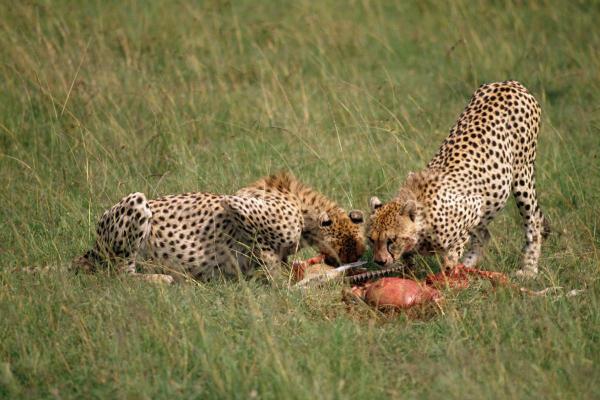
How do cheetahs hunt?
Cheetahs are known for their unique and specialized hunting technique, most characterized by their speed and agility. Similar to domestics cats, cheetahs are crepuscular animals, meaning they are most active in the early morning and before dusk. Cheetahs often avoid feeding near lions or other large predators, as they face strong competition for resources and prey.
Lions are known to be social predators and often live in prides. These packs can be aggressive and opportunistic, sometimes stealing prey from other predators, including cheetahs. Since cheetahs are generally solitary and less powerful compared to lions, they tend to avoid direct conflicts with them.
Competition for resources, including prey and territories, is a crucial part of the dynamics between different species of big cats in their natural environment. Cheetahs have developed strategies to avoid conflict with more powerful predators and maximize their chances of survival.
With this in mind, we can look at the approach cheetahs take to hunting:
- Observation and approach: cheetahs begin the hunt by stealthily observing their environment, which can be bushes and open plains such as savannahs. They use their keen sense of sight to identify potential prey, focusing primarily on medium-sized hoofed mammals. The approach is carried out with patience and stealth, minimizing detection by their potential prey.
- Active hunting strategy: unlike other big cats that rely on ambushes, cheetahs employ an active hunting strategy. Once they have identified their prey, they stealthily approach until they reach a critical distance to initiate the chase.
- Sprint at high speeds: the most distinctive characteristic of hunting cheetahs is their ability to run at high speeds for short distances. In a matter of seconds, cheetahs can reach speeds of over 100 km/h (63 mph), making them the fastest land mammals. This sprint is crucial to closing the gap between predator and prey.
- Quick and accurate strike: once the cheetah is close enough to its prey, it makes a quick and precise strike. Using its non-retractable claws and sharp teeth, it seeks to incapacitate prey by hitting it in the cervical region or by biting it on the throat to suffocate them.
- Rapid consumption: after successful capture and kill, cheetahs tend to consume their prey quickly at the hunting site. This behavior not only ensures efficient food intake, but also reduces the risk of losing prey to other predators or scavengers.
Cheetah hunting is focused on speed and agility. It reflects a unique adaptation that allows them to be highly efficient predators in the open plains of Africa and other regions where they live. This includes the famous Serengeti ecosystem of Africa which is a geographical region made of large plains.

If you want to read similar articles to Cheetah Diet - Animals That Cheetahs Eat, we recommend you visit our Facts about the animal kingdom category.
- Bissett, C., & Bernard, R. T. F. (2007). Habitat selection and feeding ecology of the cheetah (Acinonyx jubatus) in thicket vegetation: is the cheetah a savanna specialist? Journal of Zoology, 271(3), 310-317.
- Broekhuis, F., Thuo, D., & Hayward, M. W. (2018). Feeding ecology of cheetahs in the Maasai Mara, Kenya and the potential for intra‐and interspecific competition. Journal of Zoology, 304(1), 65-72.
- Marker, L. L., Muntifering, J. R., Dickman, A. J., Mills, M. G. L., & Macdonald, D. W. (2003). Quantifying prey preferences of free-ranging Namibian cheetahs. South African Journal of Wildlife Research, 33(1), 43-53.
- Schaller, G. B. (1968). Hunting behavior of the cheetah in the Serengeti National Park, Tanzania. African Journal of Ecology, 6(1), 95-100.

